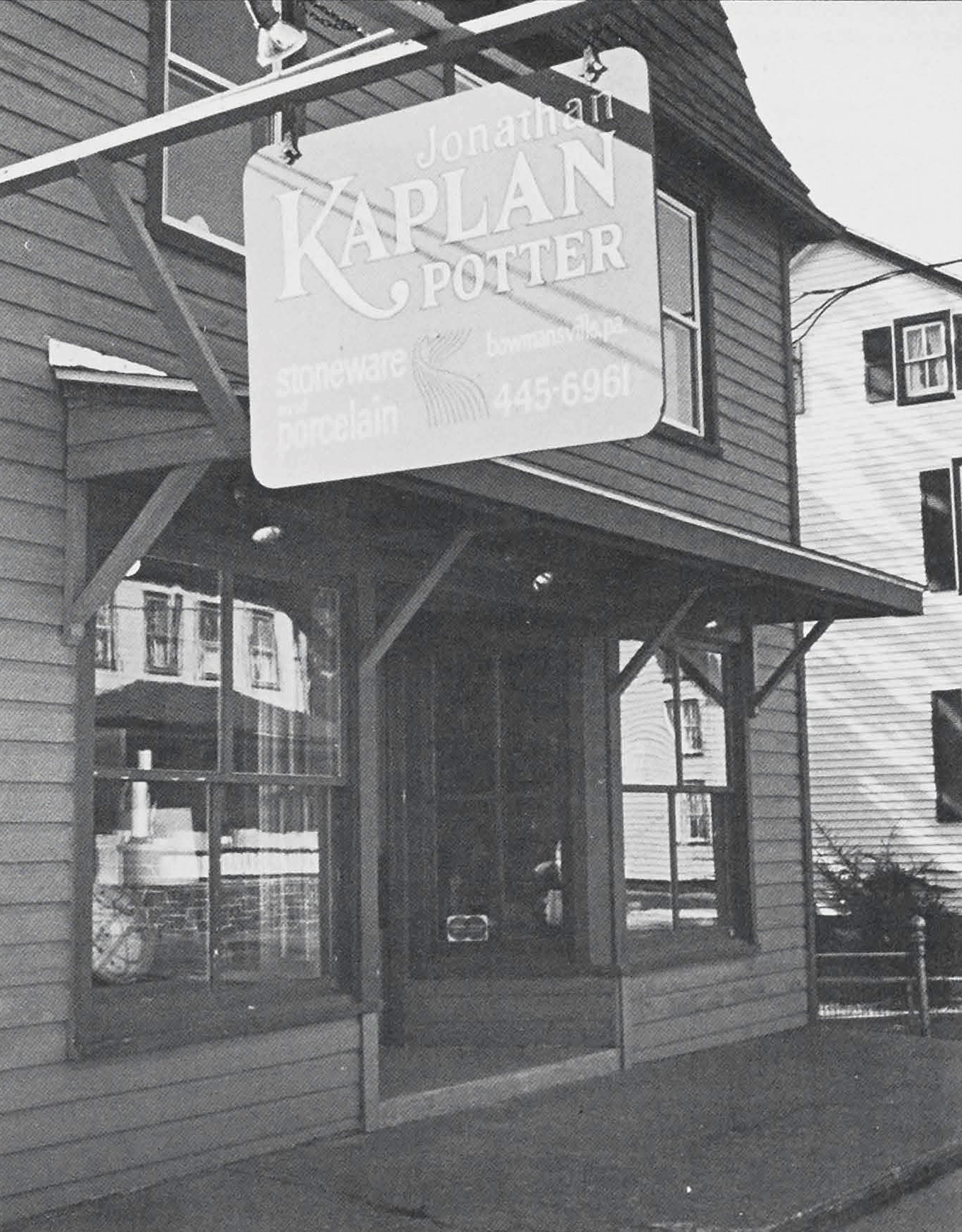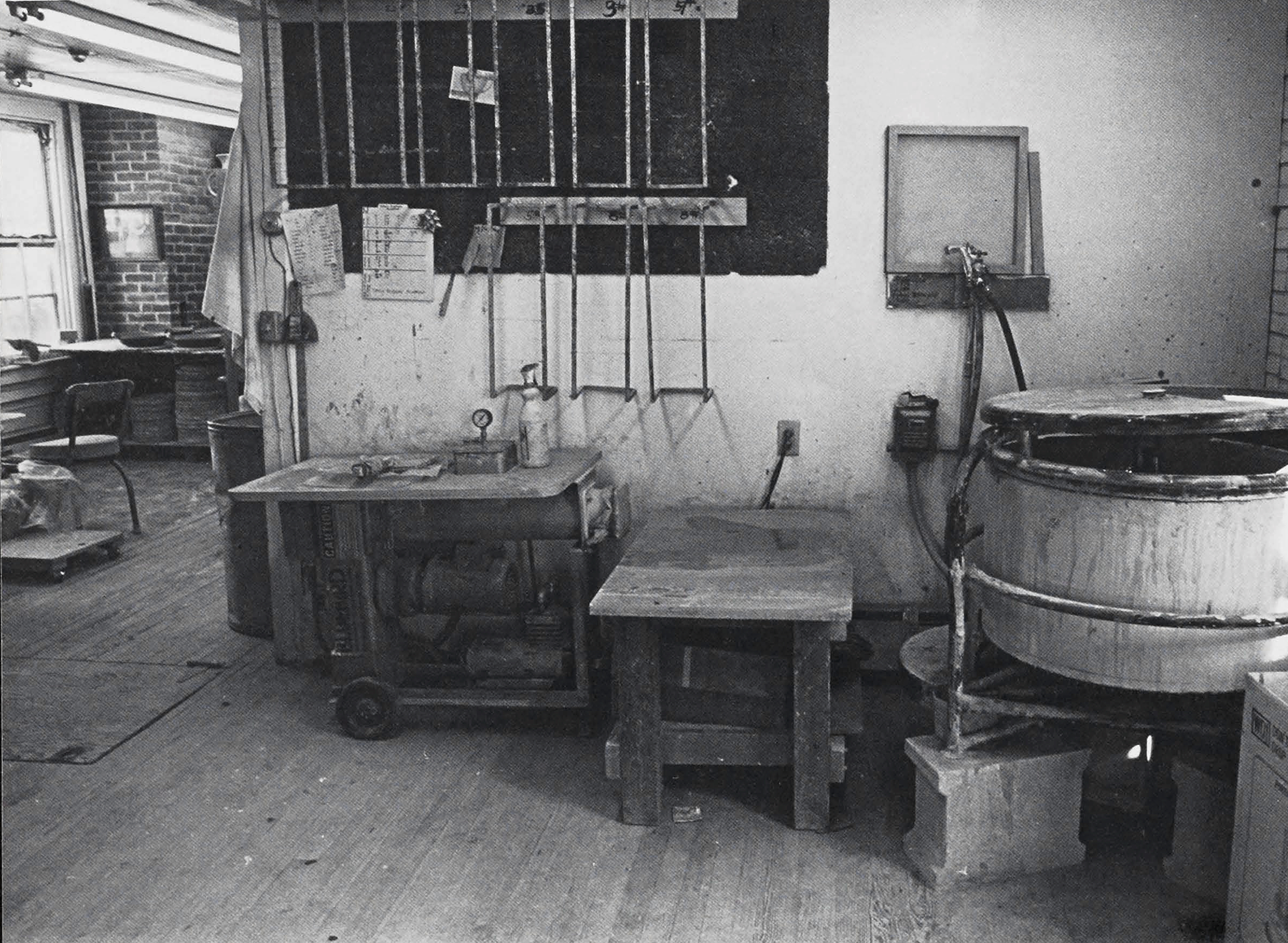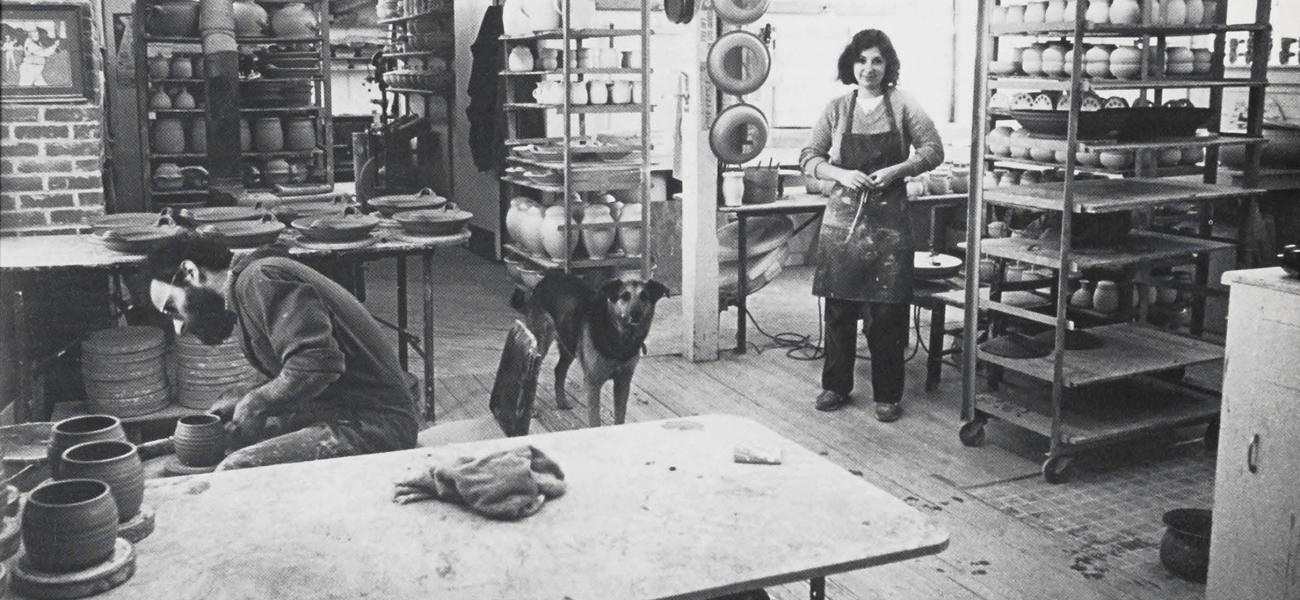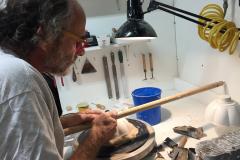Variables in Raw Materials: A Report on Contaminated Clay
There are two inherent and consciously feared occurrences in producing ceramic works in a studio. The first, within our realm of control, is poor or unsuccessful firing. The second, out of the potter's control, is bad or contaminated raw materials.
For those producing clay wares for their livelihood, either of these problems can seriously damage the work cycle, no matter what the amount or level of production. The obvious difficulties can be intuitively and logically worked out over a period of time, but the long-term effects cannot be rectified so easily. The economic consequences arising from such problems, and the ensuing questions they pose can be as devastating as the problems themselves.
We experienced such a difficulty recently with a 24-ton shipment of 30 mesh Pine Lake fireclay from the AFC Corporation mine in Hillsville, Pennsylvania.
The problem was lime contamination throughout the entire load, causing popouts in the biscuit, as well as scarred surfaces in the glazed ware. This problem is caused by expansion of the large lime particles in the clay body, and by the hydroscopic nature of hydrated lime in the ware.
Janet Huling and I produce a line of functional stoneware for a living. We're fortunate in having a spacious studio in a renovated cigar factory in Bowmansville, Pennsylvania. We have a complete floor for raw material storage alone, so buying in bulk not only provides us with a plentiful stock of supplies, but also enables us to cut out the middleman and increase our purchasing power dramatically. Our work cycle is based on firing a 100-cu ft glaze kiln once a week, supplying our pottery wholesale to over seventy-five shops and galleries throughout the country.
We have a small storefront in which we sell our seconds and a small amount of first-quality ware to the public.
Finished pottery depends on the successful sum total of each of the preceding operations in the work cycle. We have always assumed our raw materials were of ceramic grade or better and, most important, clean and without contamination. As we found out, Murphy's Law does indeed prevail: "What can go wrong, will go wrong."
As spring production progressed, we noticed an increased frequency of popouts in the biscuit. Sections of exterior as well as interior walls were blown or cracked off. A white dot was always present in the center of the popout. We had noticed these defects on a much smaller level in the past, and our theory was that perhaps some concrete from the tub of our Soldner mixer had chipped off and entered the mix, or perhaps there was some "crud" in one bag of the dry clay, and it would go away in time. As the number of popouts increased, we began to suspect the possibility of total contamination in the entire twenty-four tons. The following two glaze firings yielded devastating results and confirmed our worst suspicions.
Almost all of the ware had badly scarred surfaces—rough in texture, and usually accompanied by blisters. Popouts not seen in the biscuit surfaced in the glaze firing.
Random sampling of our Pine Lake clay in storage showed large quantities of residual material when it passed through a 24 mesh sieve. Some of this was clay material; it did slake when subjected to water. But there was a large portion of pebble-sized material that did not slake. When tested with hydrochloric acid, a gas evolved, showing a reaction between the acid and the calcium. Firing the pebbles in a biscuit kiln caused them to turn white. The evidence was becoming more and more conclusive: the problem was lime.
All of our previous schooling and education in no way prepared us to deal with this problem. In the past we had heard of bad fireclays and stoneware clays on the market. We also understood that the processors of this material would not accept liability for the products, and that, in essence many potters had to "eat it." We knew the problem was lime. What help could we expect from the AFC Corporation? What could we do with the three tons of prepared clay in stock, and what of the remaining tons of 30 mesh dry clay?
Could the lime be processed out? Finally, what about the finished pottery we had sold to stores, as well as the dry clay we had resold to other potters? We contacted Bert Lightner, Ann Powers, and Gene Passel at the office of the AFC Corporation in Canfield, Ohio.
Samples of raw clay, sieved material, biscuit ware, and finished pottery were sent to their lab. Their tests showed the presence of lime in the 30 mesh product as well as in the sieved material. As further evidence, we soaked several clean biscuit pots in water. Voila! Popouts occurred as the hydrated lime particles absorbed water and expanded. At both ends—as potters and as manufacturers and processors—we reached the same conclusion.
At about that same time, several of the potters to whom we resold some of the clay called to express the same problems. Even though legal title passes from seller to buyer, our lawyer informed us that we were liable for the material we resold.
We then contacted other potters as well as colleagues in the ceramic engineering field to get as broad an opinion as possible. What were our options?
Most suggested a finer mesh product, and further sieving of the remaining 30 mesh product to remove the larger offending lime particles. A 50 mesh grind of Pine Lake fireclay was available, and probably would not alter the shrinkage, absorption, or fired color appreciably.
We arranged to take a delivery of this finer mesh clay from AFC to replace the clay that other potters had purchased from us. We also bought a Bluebird auto-screen device to sieve the remaining 30 mesh clay. As of this writing, we have not experienced any further problems with lime contamination in our clay body, using the 50 mesh clay. There is little change in the fired characteristics, although we are adding a small percentage of Wollastonite now to encourage a stronger fired body.
What did we learn about raw materials? Being of sedimentary origin, all fireclays are mined in close proximity to both coal and limestone strata. There is always the possibility of contamination through all phases of the mining operation. Impurities can be tolerated by some branches of the ceramics industry benefication. The slightest deviation from the expected norm can yield devastating results.
With the exception of further processing by air classification, all processed clays are jaw crushed and hammermilled to the desired mesh size. A 30 mesh product contains material that is finer as well as coarser than 30 mesh, as indicated in the screen analysis available from the company. Hammer-milling reduces the clay to industrially acceptable sizes by passing it through perforated metal screens rather than through wire sieves. If contaminants are present, the chances of their passing through a perforated metal plate are much higher than the chances of their passing through a woven wire screen— the open surface area of the plate is much larger. In the 30 mesh grind we received, the lime particles were small in this case by the refractories manufacturers. In the case of the studio potter and the pottery industry, however, such impurities cannot be tolerated or absorbed. We potters cannot deal with the technology and the myriad other variables in raw materials that industry either can absorb or rectify through further processing and enough to pass through the plate, and thus pass through the processing at Hillsville, undetected until they surfaced in our ware.
Chemical analysis of processed clay will always show a small percentage of CaO. The chemistry of the product is the same, be it coarse 30 mesh or a fine air-floated 325 mesh. However, even though there is CaO present in finer grind, the material is processed finely enough to melt into the clay body matrix as a flux, and not pop out. The problem is not only one of high concentrations of lime in the clay material itself, but of the particle size of the lime.
Larger particles expand differently; they are more hydroscopic with a greater affinity for moisture. The resulting popouts in the biscuit and rough or scarred surfaces in the glazed ware are the end products of large particle lime contamination.
We incurred costs that included fork truck rental; hired labor to break down each full pallet into smaller, more manageable units; numerous phone calls; shipping costs, and so forth; not to mention the mental and financial anguish of the lost wares. This problem necessitated doing everything twice; our costs for materials increased considerably.
Our badly glazed fired loads were disposed of as seconds; the mixed clay was donated to a high school. The outstanding 30 mesh clay will be sieved and put into production.
We can honestly say we learned a lot about raw materials, having gone through a very tense, difficult time this past spring. It would have been much more stressful had it not been for the sincere and positive cooperation of the AFC Corporation, which worked with us during every stage of the problem through to its eventual solution. It is an all too pervasive attitude that because potters represent
such a small portion of the ceramic community, it is better to ignore us and not deal with our specific needs and requirements. We appreciated being able to work with the company in as constructive a way as possible, and we will continue to use 50 mesh Pine Lake clay for our pottery in the future.
ADDENDUM
Since May 1981, we have been using 50 mesh Pine Lake clay as a direct substitute for the old 30 mesh product. Our clay body formula has remained the same, except that now we add a small percentage of Vansi Brand W 10 Wollastonite. Clay is mixed once a month in a Soldner mixer, with stainless steel blades, and prior to use, pugged in a Bluebird de-airing vacuum pugmill. The resulting mix is extremely plastic, more so than the 30 mesh mix. Fired properties show little change, with the exception of an increase in shrinkage of one half percent, and a decrease in absorption of about the same amount.
As of this writing (September 1981), I have not determined whether these changes are due to the difference in mesh size of the clay or to the addition of Wollastonite. Nonetheless, the clay body performs well. The iron specking remained the same when fired to cone 10, in a reducing atmosphere at eleven percent C 0 2. The clay is well matured and vitrified, and the glazes are equally well matured. The toasty, burnt orange color of the Pine Lake clays has not been sacrificed. With the addition of Wollastonite the body has a higher green strength; it air-dries more rapidly; and it is a stronger, more durable product when fired.
Since May 1981, we have fired sixteen glaze kilns, and there has been no evidence of any lime related problems. The biscuit is clean, and no defects have surfaced on the finished wares. We feel confident about AFC, and will continue to use this material in the future.
A further note; a potter in our immediate area has been sieving his 30 mesh clay through a 24 mesh screen, using our auto-screen machine. He discards about ten percent of the clay that remains on the screen. The balance is mixed and put into production. To date, he hasn't reported any lime related problems.


